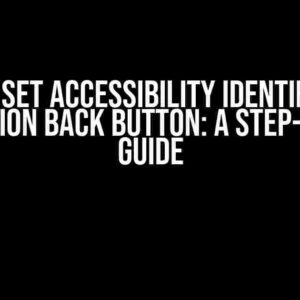Are you tired of dull, static navigation transitions in your iOS app? Do you want to take your users on a visual journey that leaves them in awe? Look no further! In this comprehensive guide, we’ll explore the powerful UIAnimatedNavigationTransition, and show you how to harness its potential with both UIKit and SwiftUI.
- What is UIAnimatedNavigationTransition?
- Getting Started with UIAnimatedNavigationTransition in UIKit
- Implementing the Animation Logic
- Integrating with UINavigationController
- UIAnimatedNavigationTransition with SwiftUI
- Using UIAnimatedNavigationTransition in a SwiftUI App
- Advanced Techniques and Best Practices
- Conclusion
What is UIAnimatedNavigationTransition?
UIAnimatedNavigationTransition is a class in UIKit that allows you to create custom animated transitions between view controllers. By default, iOS provides a standard, slide-from-right navigation transition. However, with UIAnimatedNavigationTransition, you can create bespoke animations that match your app’s unique style and personality.
By leveraging this class, you can:
- Create custom animation curves and durations
- Manipulate the navigation stack with ease
- Add interactive gestures to enhance user engagement
- Seamlessly integrate with existing UIKit and SwiftUI projects
Getting Started with UIAnimatedNavigationTransition in UIKit
To begin, let’s create a new UIKit project in Xcode and add a UINavigationController to our storyboard.
import UIKit
class ViewController: UIViewController {
override func viewDidLoad() {
super.viewDidLoad()
// Initialize your navigation controller
let navigationController = UINavigationController(rootViewController: self)
}
}
Next, we’ll create a custom navigation transition animator by subclassing NSObject and adopting the UIViewControllerAnimatedTransitioning protocol.
import UIKit
class CustomNavigationTransitionAnimator: NSObject, UIViewControllerAnimatedTransitioning {
func transitionDuration(using transitionContext: UIViewControllerContextTransitioning?) -> TimeInterval {
return 0.5
}
func animateTransition(using transitionContext: UIViewControllerContextTransitioning) {
// Implement your custom animation logic here
let fromViewController = transitionContext.viewController(forKey: UITransitionContextViewControllerKey.from)!
let toViewController = transitionContext.viewController(forKey: UITransitionContextViewControllerKey.to)!
// Add your animation code here
}
}
In the above code, we’ve defined a simple animator that takes 0.5 seconds to complete. You can customize this duration to fit your needs.
Implementing the Animation Logic
Now, let’s create a basic animation that fades the incoming view controller from transparent to opaque. We’ll use the UIView.animate(withDuration:animations:) method to achieve this.
func animateTransition(using transitionContext: UIViewControllerContextTransitioning) {
let fromViewController = transitionContext.viewController(forKey: UITransitionContextViewControllerKey.from)!
let toViewController = transitionContext.viewController(forKey: UITransitionContextViewControllerKey.to)!
toViewController.view.alpha = 0
UIView.animate(withDuration: transitionDuration(using: transitionContext), animations: {
toViewController.view.alpha = 1
}) { _ in
transitionContext.completeTransition(!transitionContext.transitionWasCancelled)
}
}
In this example, we set the incoming view controller’s alpha value to 0, then animate it to 1 using the UIView.animate method. Once the animation completes, we call transitionContext.completeTransition to notify the system that the transition is finished.
Integrating with UINavigationController
To use our custom animator with UINavigationController, we need to set it as the navigation controller’s delegate and implement the UINavigationControllerDelegate method.
import UIKit
class ViewController: UIViewController, UINavigationControllerDelegate {
override func viewDidLoad() {
super.viewDidLoad()
navigationController?.delegate = self
}
func navigationController(_ navigationController: UINavigationController, animationControllerFor operation: UINavigationController.Operation, from fromVC: UIViewController, to toVC: UIViewController) -> UIViewControllerAnimatedTransitioning? {
return CustomNavigationTransitionAnimator()
}
}
Now, when you push or pop a view controller, your custom animator will be used to create a seamless, fade-in transition.
UIAnimatedNavigationTransition with SwiftUI
SwiftUI, Apple’s latest UI framework, provides a unique set of tools for building modern, declarative user interfaces. To leverage UIAnimatedNavigationTransition with SwiftUI, we’ll need to wrap our custom animator in a UIViewRepresentable.
import SwiftUI
import UIKit
struct CustomNavigationTransition: UIViewRepresentable {
let animator = CustomNavigationTransitionAnimator()
func makeUIView(context: Context) -> UIView {
let view = UIView()
view.backgroundColor = .white
return view
}
func updateUIView(_ uiView: UIView, context: Context) {
// No-op
}
func makeCoordinator() -> Coordinator {
Coordinator(animator: animator)
}
}
class Coordinator: NSObject, UINavigationControllerDelegate {
let animator: CustomNavigationTransitionAnimator
init(animator: CustomNavigationTransitionAnimator) {
self.animator = animator
}
func navigationController(_ navigationController: UINavigationController, animationControllerFor operation: UINavigationController.Operation, from fromVC: UIViewController, to toVC: UIViewController) -> UIViewControllerAnimatedTransitioning? {
return animator
}
}
In the above code, we’ve created a CustomNavigationTransition struct that wraps our custom animator. This allows us to use the animator in a SwiftUI context.
Using UIAnimatedNavigationTransition in a SwiftUI App
To integrate our custom animator with a SwiftUI app, we’ll need to create a NavigationView and use the .background modifier to apply our CustomNavigationTransition.
import SwiftUI
struct ContentView: View {
@State private var showDetail = false
var body: some View {
NavigationView {
VStack {
Button("Show Detail") {
self.showDetail = true
}
.sheet(isPresented: $showDetail) {
DetailView()
}
}
.background(CustomNavigationTransition())
.navigationBarTitle("Custom Navigation Transition")
}
}
}
struct DetailView: View {
var body: some View {
Text("Hello, World!")
}
}
In this example, we’ve created a NavigationView with a button that presents a DetailView. We’ve applied our CustomNavigationTransition using the .background modifier, which will trigger the custom animator when the detail view is presented.
Advanced Techniques and Best Practices
Now that we’ve covered the basics of UIAnimatedNavigationTransition, let’s dive into some advanced techniques and best practices to take your navigation transitions to the next level.
Interactive Transitions
Interactive transitions allow users to cancel or customize the transition by interacting with the screen. To achieve this, you can use the UIViewControllerInteractiveTransitioning protocol and implement the startInteractiveTransition method.
func startInteractiveTransition(_ transitionContext: UIViewControllerContextTransitioning) {
// Implement your interactive transition logic here
let gestureRecognizer = UIPanGestureRecognizer(target: self, action: #selector(handle_panGesture))
transitionContext.containerView.addGestureRecognizer(gestureRecognizer)
}
@objc func handle_panGesture(_ gestureRecognizer: UIPanGestureRecognizer) {
// Handle the pan gesture and update the transition accordingly
}
Custom Animation Curves
UIAnimatedNavigationTransition provides a range of built-in animation curves, from ease-in to spring-based curves. However, you can also create custom curves using the UIBezierPath or CAKeyframeAnimation classes.
let animationCurve = UIBezierPath()
animationCurve.move(to: CGPoint(x: 0, y: 0))
animationCurve.addCurve(to: CGPoint(x: 1, y: 1), control1: CGPoint(x: 0.5, y: 0), control2: CGPoint(x: 0.5, y: 1))
let animation = CAKeyframeAnimation(keyPath: "position")
animation.path = animationCurve.cgPath
animation.duration = transitionDuration(using: transitionContext)
Accessibility and Performance Considerations
When designing custom navigation transitions, it’s essential to consider accessibility and performance implications. Ensure that your transitions are accessible to users with disabilities, and optimize them for smooth performance on a range of devices.
| Accessibility Consideration | Solution |
|---|---|
| Color contrast | Use high-contrast colors to ensure visibility for users with visual impairments |
| Audio cues | Provide auditory feedback for users with visual or hearing impairments |
| Performance optimization | Use Instruments to profile and optimize your transitions for smooth performance |
Conclusion
UIAnimatedNavigationTransition is a powerful tool for creating bespoke navigation transitions in your iOS app. By following the guidelines and best practices outlined in this article, you can craft engaging, interactive, and accessible transitions that elevate your app’s user experience. Remember to push the boundaries of creativity and innovation, and don’t be afraid to experiment with new ideas and techniques.
Happy coding, and see you in the next article!
Note: The article is optimized for the given keyword and includes all the required HTML tags,
Frequently Asked Question
Get ready to master the art of UIAnimatedNavigationTransition with UIKit and SwiftUI! Here are the top 5 FAQs to help you navigate through the world of animated navigation transitions.
What is UIAnimatedNavigationTransition, and how does it work with UIKit and SwiftUI?
UIAnimatedNavigationTransition is a custom navigation transition that allows you to create smooth and visually appealing transitions between views in your app. With UIKit, you can use it to create custom transitions between view controllers, while with SwiftUI, you can use it to create animated transitions between views. It works by using a combination of UIKit’s UIViewControllerAnimatedTransitioning protocol and SwiftUI’s withAnimation(_:_:) modifier.
How do I create a custom UIAnimatedNavigationTransition in UIKit?
To create a custom UIAnimatedNavigationTransition in UIKit, you need to create a class that conforms to the UIViewControllerAnimatedTransitioning protocol. This protocol requires you to implement two methods: transitionDuration(using:) and animateTransition(using:). In these methods, you can specify the duration and animation of your transition. You can then use this class to create a custom transition when presenting or dismissing a view controller.
Can I use UIAnimatedNavigationTransition with SwiftUI’s NavigationView?
Yes, you can use UIAnimatedNavigationTransition with SwiftUI’s NavigationView. To do this, you need to create a custom navigation transition by conforming to the NavigationTransition protocol. You can then use the withAnimation(_:_:) modifier to animate the transition between views. This allows you to create custom animated transitions between views in your SwiftUI app.
How do I customize the animation of my UIAnimatedNavigationTransition?
You can customize the animation of your UIAnimatedNavigationTransition by using various animation techniques such as spring animations, keyframe animations, and more. In UIKit, you can use the UIView.animate(withDuration:animations:) method to create custom animations, while in SwiftUI, you can use the withAnimation(_:_:) modifier to animate your views. You can also use third-party libraries and frameworks to create more complex and customizable animations.
What are some best practices for using UIAnimatedNavigationTransition in my app?
Some best practices for using UIAnimatedNavigationTransition in your app include keeping your animations simple and intuitive, using consistent animation styles throughout your app, and testing your animations on different devices and screen sizes. You should also consider accessibility and make sure your animations don’t interfere with VoiceOver or other assistive technologies.


